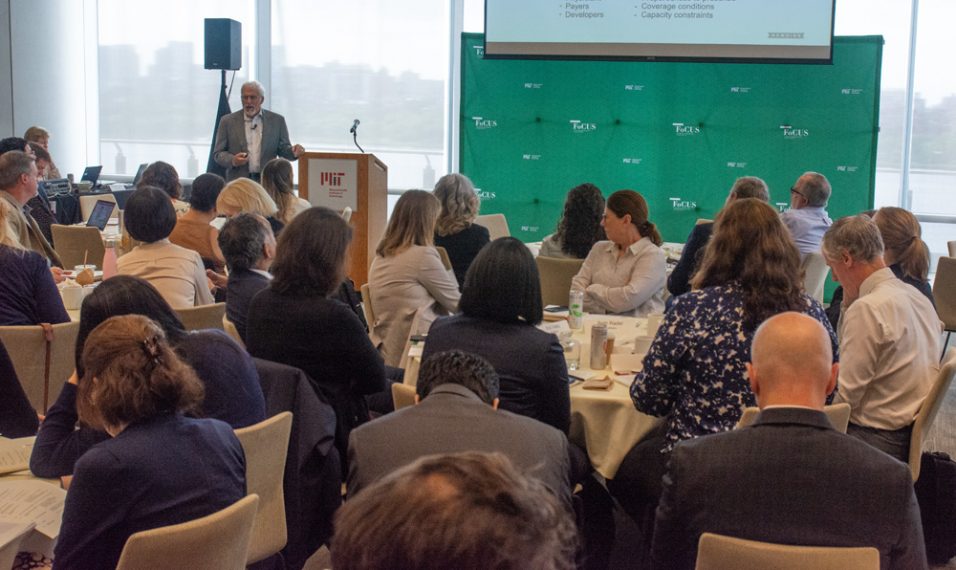Daylong session gathered leaders from across the national healthcare innovation landscape
The NEWDIGS Initiative at the Massachusetts Institute of Technology held a Paying for Cures Workshop on August 7, attended by 90 participants from patient advocacy groups, pharmaceutical companies, healthcare provider organizations, and health insurance companies. They explored the challenges and precision financing solutions for emerging gene and cell therapies that offer potential cures to disease but which also present high upfront costs and complex payment and financing considerations.
The workshop shared research findings from the Financing and Reimbursement of Cures in the US (FoCUS) Project at NEWDIGS, and engaged participants in discussion about adapting practices and tools for meeting financing challenges in their organizations.
Mark Trusheim, Strategic Director for NEWDIGS, emphasized at the start of the workshop that collaborative problem solving would be its main focus. “This is not a graduate student seminar in which the student who comes up with the most issues on the flip chart wins,” he said. “This is about all of us trying to find ways to solve these problems that works for everyone, patients, most of all, but it also has to work for payers, innovators, healthcare providers, and all the channels in between.”
Michelle Harika of Equity Healthcare commenced the program with an overview discussion about the nature of the new therapies, the various stakeholder perspectives on them, and the concerns they raise. Colin Young of MIT followed up with a detailed presentation of the FoCUS Drug Development Pipeline analysis of the durable cell and gene therapies in the pipeline and their impact on patient populations by incidence and prevalence. One finding of their analysis shows that annual reimbursements for cell and gene therapies could reach $20 billion to $30 billion by 2031.
Trusheim then introduced the FoCUS Project’s Precision Financing Strategies, the collection of tools and practices that organizations can begin to use to address cell and gene therapies’ financing complexities. Among these tools are performance-based annuities and milestone-based contracting, as well as an ORBM (Orphan Reinsurance Benefit Manager).
Dan Mytelka, another member of the FoCUS Project team, highlighted specific policy challenges to performance-based agreements, seen as key financing tools. Among those challenges are patient mobility, information privacy, FDA Communications, and insurance regulations. Mytelka then moderated a cross-stakeholder panel discussion including Diane Berry (Sarepta), Kaha Hizanishvili (MassHealth), Brendan Hayes (National Hemophilia Foundation), and Desiree Otenti (Blue Cross Blue Shield of Massachusetts).
On the challenge of patient mobility and the cost to insurers for expensive but durable therapies, Otenti said, “I think we’re taking a theoretical pricing framework but not applying the same framework to payment. We have pricing based on a lifetime of value,” but ask a specific group of people—those in a health insurance plan—to bear the costs in a single year and bear increased premiums.
The workshop featured an informal presentation by Jeff Lucas, Policy Advisor in Office of Senator Bill Cassidy, who has taken a leadership role in exploring financing solutions. Lucas fielded questions from the participants, giving them insights into the policymaking process and prospects for legislative changes in the coming months.
Policy remained the focus for the next panel, moderated by Brian Carey (Foley Hoag), and including Rob Falb (Alliance for Regenerative Medicine), Michael Sherman (Harvard Pilgrim Healthcare), Kristin Wolff (bluebirdbio), and John Martin (CRISPR Therapeutics). Their discussion centered on proposed regulatory and legislative changes that could potentially enable the use of performance-based contracting and the implications of the Medicaid Drug Rebate Program to their use.
Speaking on the difficulty of getting legislative action, Falb noted, “We can be talking about the cures, about all the positives to [these therapies] but often the first question is, aren’t those the drugs that cost millions of dollars? …There are certain members of Congress who are enlightened and understand the potential and the importance of this issue but the vast majority of the policymakers don’t have the time or the bandwidth to really delve in and understand it. That’s why it’s incumbent upon me, everybody on this panel, and everybody in this room to try to educate the members of Congress.”
Finally, Michael Ciarametaro (National Pharmaceutical Council) hosted a “fireside chat” discussion between Krishna Komanduri (University of Miami Health System) and Edward Abrahams (Personalized Medicine Coalition) on challenges for fair provider payments under the scenario of high cost therapies and potential changes in revenue streams with “one and done” type therapies.
“I think the answer has to come back to paying for value,” said Abrahams on the issue of high costs. “It seems to me we should focus less on the price of the drug—$2.1 million, whatever it’s going to be—and more on the systemic costs. Paying for sickness just doesn’t seem to make sense. …Otherwise, the price tags are going to drive the argument instead of what do we want as a society?”
NEWDIGS is planning for a second Paying for Cures Workshop in March 2020 with a special emphasis on tools that stakeholders can use to assess financial risk and prepare for the arrival of new cell and gene therapies.
Photo: Dr Colin Young, MIT FoCUS Project, presenting the pipeline analysis at the Paying for Cures Workshop
